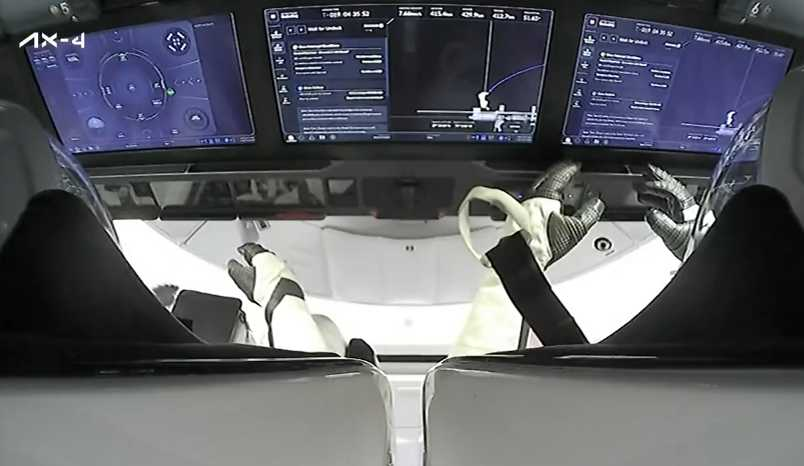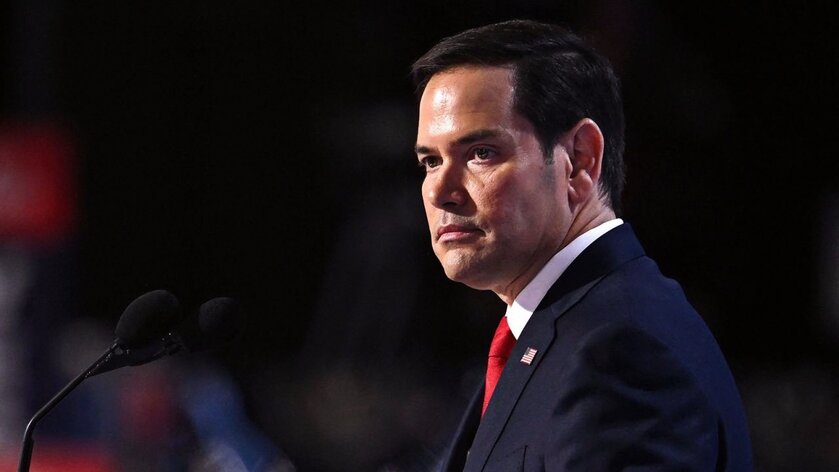The SpaceX Crew Dragon spacecraft 'Grace' carrying the four-member Axiom Mission 4 (Ax-4) crew, undocked from the International Space Station (ISS) on July 14 at 1115 UTC. The undocking followed hatch closure at 0907 UTC and alignment confirmation, marking the beginning of the crew's 22.5-hour return journey to Earth.
Ax-4's commander and former NASA astronaut Peggy Whitson, is now Houston-based Axiom Space's director of human spaceflight. "Space Station, Grace," Whitson said over the communication system as the Crew Dragon crossed out of the ISS's safety "keep-out sphere," "The Ax-4 crew wants to thank you very much for your support. You guys are amazing."
Whitson's crewmates are pilot Shubhanshu "Shux" Shukla and mission specialists Sławosz "Suave" Uznański-Wiśniewski and Tibor Kapu. This was the first spaceflight for each of those three. But Ax-4 is Whitson's fifth mission to orbit and raises her current record for most cumulative days in space by an American to 695.
The Ax-4 crew took on more than 60 experiments and technology demonstrations with contributions from 31 different nations, as well as a number of public outreach events, breaking a record for Axiom as it continues to hone its orbital operations.
Grace docked to the ISS on June 26. Ax-4, Axiom's fourth to the space station, is an extension of the Houston-based company's previous crewed flights, with research and science investigations aimed at furthering understandings of the microgravity environment.
The mission, which lasted ~2.5 weeks, will conclud with the spacecraft splashdown off the California coast on July 15. This will be SpaceX's second West Coast crew recovery. The first was that of the Crew-9 ISS mission in March.
SpaceX shifted to Pacific Ocean rather than Atlantic or Gulf recoveries, after instances of debris from Dragon's trunk surviving atmospheric reentry and crashing back to Earth.
==================
The SpaceX Ax-4 Crew Dragon "Grace" docked with the International Space Station (ISS) at 1031 UTC on June 26, and the hatches between the spacecraft and the station were opened at 1214 UTC. The station's current crew, including Exp. 73 commander JAXA astronaut Takuya Onishi, welcomed the Ax-4 astronauts abaord.
The spacecraft had launched from NASA’s Kennedy Space Center in Florida on a Falcon 9 rocket at 0631 UTC on June 25 for Houston-based Axiom Space, completing a 28-hour orbital journey to the space station.
Welcoming the Ax-4 crew mission commander Peggy Whitson, mission pilot Shubhanshu Shukla (India), mission specialists Sławosz Uznański (Poland) and Tibor Kapu (Hungary), Onishi noted the presence of 11 astronauts from six countries on the ISS. He welcomed the crew, stating, “With your arrival right now, there are 11 astronauts from six countries, and all of us are here in order to advance human space exploration and scientific research, symbolizing international cooperation.”
The Ax-4 crew received their astronaut wings during the ceremony, with Whitson expressing appreciation for the support provided by the ISS crew and Kapu describing the Expedition 73 team as “the best crew” to join.
The Ax-4 crew will work alongside the Expedition 73 members, including NASA astronauts Anne McClain, Nichole Ayers, and Jonny Kim, JAXA’s Onishi, and Roscosmos cosmonauts Sergey Ryzhikov, Kirill Peskov, and Alexey Zubritsky.
"We're looking forward to getting a lot of work done with you guys, and I really appreciate all the support you provided for to us in advance of actually even getting here," Whitson said in response to Onishi.
"I'm very, very confident that the next 14 days are going to be amazing, advancing science and research and working together," said Shukla, mentioning that the view so far had surpassed his expectations.
"This is an ultimate scientific laboratory where we come to do science, to test the technologies of our countries, to do technology demonstrations and science outreach that I can't wait to do for the for the next two weeks, and we will all try to do our best representing our countries," Uznański said as he was handed the microphone.
Finally, as his wings were clipped to his jumpsuit, "I really feel that this is the best crew that you could join. It really feels great to be part of Expedition 73," said Kapu. "I'm 100% sure that this is going to be awesome."
The Ax-4 mission, a private astronaut mission, will last approximately 14 days, during which the crew will conduct over 60 scientific experiments, including seven proposed by India, such as studying water bears (tardigrades) in microgravity and investigations in bio-manufacturing and bio-astronautics.
==================
A Falcon 9 rocket launched SpaceX's newest Dragon spacecraft, named "Grace," at 0631 UTC on June 25, 2025, from Launch Complex-39A at NASA's Kennedy Space Center. The Ax-4 mission for Houston-based Axiom Space, to the International Space Station (ISS) is carrying former NASA astronaut Peggy Whitson, who is also Axiom's director of human spaceflight. Alongside her are mission pilot Shubhanshu Shukla and specialists Sławosz Uznański-Wiśniewski and Tibor Kapu.
The Falcon 9 first stage booster (B1094) touched down safely as planned about ~8 minutes after liftoff at SpaceX's Landing Zone 1(LZ 1) at Cape Canaveral Space Force Station.
About a minute later, the Falcon 9's second stage completed its orbital insertion and deployed Dragon to begin the final leg of Ax-4's journey to the space station.
The Dragon spacecraft is scheduled to dock with the dorsal port of the space station's Harmony module at approximately 1100 UTC on June 26.
Grace is the fifth Crew Dragon in SpaceX's fleet, and was named by the Ax-4 crew, with its name symbolizing elegance and harmony in space exploration. Ax-4 is the Dragon's debut mission carrying the crew of four to the International Space Station (ISS). The spacecraft featured upgraded life-support systems, touchscreen controls, and autonomous docking capabilities.
The crew shared images of their mission's zero-g indicator, a plush baby swan toy named Joy, symbolized cultural values—wisdom (India), resilience (Poland), and grace (Hungary)—and signaled the crew’s arrival in microgravity.
The Ax-4 crew will spend about two weeks aboard the ISS, living and working alongside the seven long-term occupants of ISS Expedition 73. They will conduct more than 60 science experiments and STEM outreach events, the highest number on any Axiom mission to date, representing 31 countries, including the U.S., India, Poland, Hungary, and others.
The experiments focuses on:
Human Research: Studies on muscle regeneration and the impact of isolation on mental health.
Life and Biological Sciences: Investigations into how sprouts, edible microalgae, and tiny aquatic organisms grow and survive in microgravity.
Earth Observation: Research to support environmental monitoring.
Material Sciences: Technology demonstrations for future space applications.
The crew trained extensively for ISS operations, with access to the U.S. segment of the station, including the Columbus and Kibō modules. Educational outreach included interactive events with schools and communities in the crew’s home countries.
This mission marks the first time people from India, Poland, and Hungary have flown together to the ISS and represents the return of these countries to human spaceflight for the first time in 40 years It is also the fourth private astronaut mission to the ISS.
Whitson is a former NASA astronaut and Axiom Space’s Director of Human Spaceflight. She is the most experienced American astronaut, with 675 days in space prior to this mission. This was her fifth spaceflight and second time commanding an Axiom mission. She holds records for the most spacewalks by a female astronaut (10) and the most cumulative time in space by a U.S. astronaut.
Shukla is a Group Captain in the Indian Air Force and an astronaut with the Indian Space Research Organisation (ISRO). Shukla became the second Indian to reach space and the first to serve in a critical operational role on an ISS mission. With over 2,000 hours of flight experience, he trained at the Yuri Gagarin Cosmonaut Training Center in Russia and is part of India’s Gaganyaan program, set for 2027.
Uznański-Wiśniewski is a European Space Agency (ESA) project astronaut from the 2022 Astronaut Reserve Class. Uznański-Wiśniewski was the second Polish astronaut to travel to space and the first since 1978. An engineer with experience at CERN’s Large Hadron Collider, he trained extensively in Europe, Japan, and the U.S. for the mission, carrying the Polish flag from the 1978 mission.
Kapu is representing the Hungarian to Orbit (HUNOR) program. Kapu was the second Hungarian astronaut to reach space and the first to visit the ISS. A mechanical engineer with expertise in space radiation protection, he was selected from 247 applicants and trained at NASA facilities.
"It has been more than 40 years since the first person from India, Poland and Hungary has been to space, and through this commercial space opportunity we are accelerating the national space programs in each of these three countries and creating new pathways for technological advancements," Whitson said at the crew's January press conferece. "I'm sure this crew is going to be inspiring a whole new generation of young people."
This is the second Axiom astronaut mission to the ISS that has been sponsored in part by another national government or the European Space Agency (ESA). Of the 60 experiments to be carried out by the Ax-4 crew, 17 are being supported by ESA and Poland, and 25 through Hungary's orbital astronaut program HUNOR.
"Each country who comes brings something different than what we have in the normal suite of what we see for our research," said NASA's ISS program manager Dana Weigel during a May 20 Ax-4 press call. "It really expands the breadth of what we can do with research and the number of countries, institutions, academic organizations, etc., who participate."
Thursday's launch was initially scheduled for June 11 but was delayed due to high altitude winds and a leak aboard the ISS.
The space station's aftmost module, Zvezda, has experienced an ongoing leak for more than five years now, but has remained stable during that time. Last week, a change in the pressure data that monitors the leak prompted NASA to delay Ax-4 while they monitored the issue.















